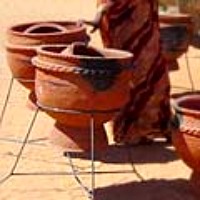 Most people living in rural areas and many living in urban areas cannot afford to buy an electric refrigerator and an alternative method such as the clay refrigerator can act as an appropriate substitute. The clay refrigerator project was first initiated by Practical Action in 2001 following research conducted by Practical Action Country Director Mohammed Majzoub who had heard about the idea being promoted by a teacher named Mohammed Bah Abba in Nigeria. Following the successful experiments conducted by Practical Action and Al Fashir University to measure the clay refrigerators value in maintaining nutrients and extending the shelf life of vegetables, training was given to 21 ladies from the Al Fashir Association for Earthenware Manufacturing on how to make the cooler.
Most people living in rural areas and many living in urban areas cannot afford to buy an electric refrigerator and an alternative method such as the clay refrigerator can act as an appropriate substitute. The clay refrigerator project was first initiated by Practical Action in 2001 following research conducted by Practical Action Country Director Mohammed Majzoub who had heard about the idea being promoted by a teacher named Mohammed Bah Abba in Nigeria. Following the successful experiments conducted by Practical Action and Al Fashir University to measure the clay refrigerators value in maintaining nutrients and extending the shelf life of vegetables, training was given to 21 ladies from the Al Fashir Association for Earthenware Manufacturing on how to make the cooler.
A lidded earthenware pot is fitted inside a larger pot with an insulating layer of sand in between. This sand layer can be kept cool by adding water at regular intervals (generally twice a day), thus providing a refrigerated storage space at minimal cost.
As water in the sand evaporates through the surface of the outer pot, it carries heat, drawing it away from the inner core, thus cooling the inside of the inner pot.
 The potteries association in Al Fashir made and sold over 50 ceramic refrigerators in 2007 which cost $20 to buy. The ceramic refrigerator has proved very successful and it has been tested with a number of different vegetables. For example tests have shown that these foods can be kept fresh for the following amount of time:
The potteries association in Al Fashir made and sold over 50 ceramic refrigerators in 2007 which cost $20 to buy. The ceramic refrigerator has proved very successful and it has been tested with a number of different vegetables. For example tests have shown that these foods can be kept fresh for the following amount of time:
- Tomatoes – 3 weeks
- Guavas – 3 weeks
- Carrots – 3 weeks
- Okra – 2 weeks
Instructions:
- The first task that needs to be performed is the making of the molds. To do this make a small hole in the ground and cover it with a mat. Cover the mat with a small amount of wood chippings to prevent sticking.
- Mix and knead an even mixture of mud, dung and water into a ball.
- Repeatedly press a stone into the mixture to form a bowl shape. Continue to do this adding more material if necessary until the mold reaches the correct dimensions.
- Once the molds have been made they need to be left to dry in the sun for 30 minutes.
- Now work can start on making the pots. Once again a small hole is prepared with a coating of wood chippings.
- The clay is kneaded into a doe like mixture.
- The clay mixture is rolled flat and then placed on an upside down mold. The thickness of the mixture should be in the region of 10 mm. Following this the mixture is spread over the mold as far down as the molds widest diameter. Using a flat stone and some water the surface is smoothed out.
- Once the round shape has been formed the walls can be extended to the designated height. This is done by removing the mold and adding clumps of the mixture by hand to the wall.
- An extra thick layer is then added as a rim which is roughly 20 mm thick. The small pot is now complete.
- The next step is to make the big pot. This process is similar to the making of the small pot with a couple of extra steps. Firstly follow steps 5 – 7 using the large mold.
- Once the mixture has been spread evenly over the surface of the mold the base is formed using extra mixture by hand.
- The walls can now be extended to the designated height. This is done by removing the mold and adding clumps of the mixture by hand to the wall.
- An extra thick layer is then added as a rim which is roughly 30 mm thick.
- The final part of this process is to add the decoration around the outside of the pot. This is done by rolling the mixture into a long sausage shape and sticking it around the outside of the pot about two thirds of the way up. The pattern is made by pressing your fingers into it. The large pot is now complete.
- Both pots are now left in the sun to dry. This normally takes four days in the winter and two days in the summer.
- The next process is for the pots to be burned. To make this process more efficient it is better to burn as many pots as possible at once. Firstly an area is cleared and a circle is made with rocks. The ground is then covered with cow dung.
- The clay pots are then piled in the middle and completely covered with sticks and more dung. The fire is then lit and left to burn for 24 hours.
- Once the clay pots have been burnt the clay refrigerator can be assembled. Firstly sand should be placed in to the bottom of the large pot forming a layer approximately 5 cm in depth. At this point the small pot should be placed inside the big pot on top of the sand. This should mean that the tops of each pot are now level. Sand can now be put around the outside of the big pot until it is flush with the surface.
- Ideally the clay refrigerator should be held in a stand to allow airflow underneath to help with the cooling process.
- A damp cloth should be placed on top of the inner storage pot to prevent hot air entering.

Source and Photos: www.practicalaction.org